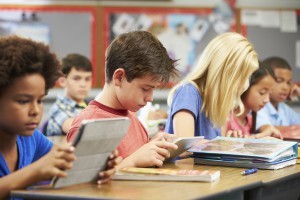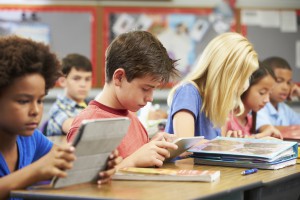
There’s no better satisfaction for Eliana Rojas than the moment a student suddenly understands something in the classroom. Over the coming school year, the Neag School associate professor-in-residence suspects that many more of those “got-it” moments will be happening in one local school.
Last month, Rojas presented 30 iPads and a charging cart to Windham Middle School in Windham, Conn., as part of Mathematics Literacy in English Across Disciplines (Math LEAD) – an initiative that seeks to improve math instruction for the school’s large population of English language learners (ELLs).
Nearly 80 percent of Windham’s population are non-native English speakers, a dynamic that poses a challenge for teachers trying to ensure that students understand not only English, but also the language of mathematics.
“The classroom environment [at Windham Middle School] is very diverse. They come from many different countries and communities and speak several different languages,” says Rojas, Math LEAD project director. In fact, she says, nearly 80 percent of Windham’s population are non-native English speakers, a dynamic that poses a challenge for teachers who are trying to ensure that students understand not only English, but also the language of mathematics.
For the middle schoolers, Rojas says, completing math lessons and playing math games on the iPads empowers them to learn.
“There is no challenge for the kids to use the technology,” she says. “The kids are miracles. They will try anything.”
Math LEAD is part of a five-year, $2 million grant from the U.S. Department of Education. The donated iPads, which will ultimately help to enhance the learning of more than 450 students, are just one of the program initiatives intended to prepare ELLs for college-level mathematics and STEM-related fields.
Since 2005, Rojas has helped secure roughly $6 million in grant funding that has supported professional enhancement and bilingual education on a number of fronts. For instance, Windham Middle School benefited from this funding last year, too, as 30 graphing calculators were purchased for the school. In addition, the LEAD program trains elementary, middle, and high school teachers in three major competency areas: cultural, social, and linguistic. It also trains teachers in culturally relevant pedagogy, including how to understand diverse social conditions and how to tailor lessons to students’ individual needs. The most qualified instructors are encouraged to complete a master’s degree or sixth-year diploma in bilingual/TESOL education through the Neag School of Education.
As much as Rojas hopes bilingual instructors master teaching mathematics to ELLs, the true measure of success, she says, is when students understand the material well enough to teach it to their peers.
“The best thing is when a student can teach [mathematics] to the other kids,” Rojas says. “That’s the reproduction of knowledge.”



